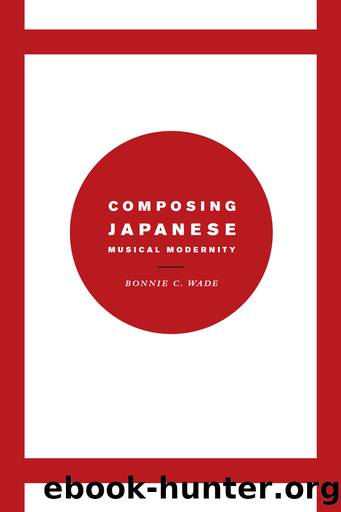Composing Japanese Musical Modernity by Bonnie C. Wade;

Author:Bonnie C. Wade; [Wade, Bonnie C.]
Language: eng
Format: epub
Publisher: University of Chicago Press
Published: 2013-10-14T16:00:00+00:00
CHAPTER SIX
Composing for Chorus
In postâWorld War II Japan, just as orchestras and wind bands were forming in considerable numbers, the practice of choral singing became an extremely popular musical activity. So positive has been the reception to choral singing, so widespread have choruses become for citizens of all ages, that they offer a significant affordance for composers. The conditions of possibility for that to happen, I suggest, were put in place from the very beginning of the modernization processâboth institutionally and, for composers, attitudinally. While some individuals specialize in writing choral music, composing for chorus became just part of what many composers do. Because, as in Europe and the United States, most (but not all) composers put writing for chorus lower on the musical evaluative pecking order than writing for instruments, I explore in this chapter why they take advantage of the affordance as they do.
One clarification is in order. By âchoral musicâ I mean for the most part sung multi-part music, whether heterophonic, polyphonic, or homophonic.1 However, when it comes to Japanese choral music it is crucial to recognize that the monophonic texture of unison is frequently utilized by composers and performers as a textural option. My idea about why this is so has to do with the close relationship between performance of song and choral music, and between song for children and that for adults, which I address below.
I will first situate the practice of choral singingâthat is, the chorus as a type of performance ensembleâin the environment of European spheres of musical participation in Japan. This I will do chronologically, tracing the emergence of the practice and its positive reception as it was invoked in response to needs that emerged from sociopolitical imperatives of the processes of modernization (see the frontispiece). Again, connectivities among the major infrastructures of modernizationâeducation, government, industry, and commerceâfor the propagation of choral music are in evidence.
In this chapter another process of modernizationâthat is, urbanizationâcomes into play, and the agency of individuals is again shown to be significant: responses of individual composers and conductors to both the needs of the nation and the desires of Japanese modernity can be seen to have resulted in individual initiatives of considerable force. Finally, I consider some composersâ artistic motivations for involving themselves in the choral sphere, and some musical results. This chapter offers perhaps the most telling evidence of the socially relational nature of composers and composing in Japan today.
SITUATING CHORAL SINGING IN JAPAN
Japan is one of the countries in which choruses are extremely popular. Including all the choruses in elementary schools, junior and senior high schools, colleges, companies, womenâs groups, and private groups of ordinary individuals, there are said to be between twenty and thirty thousand choruses in Japan today. All the people who belong to these choruses are becoming more familiar with music while enjoying themselves in chorus activities, which is certainly transforming Japan into a stage on which its singers are greatly improving the musical culture of the land. (http://www.jcanet.or.jp/inter/JCA_guide.html, accessed August 8,
Download
This site does not store any files on its server. We only index and link to content provided by other sites. Please contact the content providers to delete copyright contents if any and email us, we'll remove relevant links or contents immediately.
Papillon by Henry Charrière(796)
Watercolor With Me in the Forest by Dana Fox(589)
The Story of the Scrolls by The Story of the Scrolls; the M(556)
This Is Modern Art by Kevin Coval(459)
A Theory of Narrative Drawing by Simon Grennan(456)
Frida Kahlo by Frida Kahlo & Hayden Herrera(445)
Boris Johnson by Tom Bower(442)
Banksy by Will Ellsworth-Jones(435)
AP Art History by John B. Nici(429)
Van Gogh by Gregory White Smith(426)
The Art and Science of Drawing by Brent Eviston(423)
Draw More Furries by Jared Hodges(422)
Glittering Images: A Journey Through Art From Egypt to Star Wars by Camille Paglia(419)
War Paint by Woodhead Lindy(414)
Scenes From a Revolution by Mark Harris(413)
100 Greatest Country Artists by Hal Leonard Corp(391)
Ecstasy by Eisner.;(386)
Young Rembrandt: A Biography by Onno Blom(374)
Theater by Rene Girard(355)
